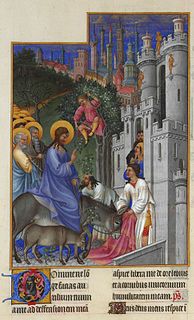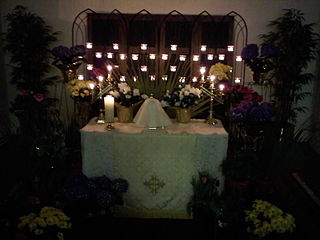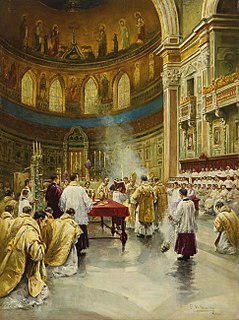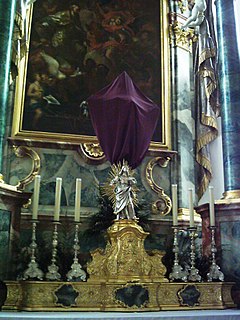 W
WIn Christianity, Holy Week is the week immediately preceding Easter. It is also the last week of Lent, in the West, – Palm Sunday, Holy Monday, Holy Tuesday, Holy Wednesday, Maundy Thursday, Good Friday, and Holy Saturday – are all included. However, Easter Day, which begins the season of Eastertide, is not.
 W
WThe altar of repose is an altar where the Communion hosts consecrated on Maundy Thursday during the Mass of the Lord's Supper are placed, or "reserved", for use on the following day, Good Friday. The altar can be found in Roman Catholic, Anglican, and some Lutheran churches. Good Friday is the day on which the death of Christ is observed. His Resurrection is not observed until Easter Sunday and the anticipatory Easter Vigil on Holy Saturday. Between the time of his death and resurrection, mass is not celebrated, and so communion hosts cannot be consecrated. Any hosts used on Good Friday must have been consecrated previously.
 W
WThe Chrism Mass is a religious service held in Roman Catholicism, Lutheranism, and Anglicanism.
 W
WPsalm 22 is the 22nd psalm of the Book of Psalms, generally known in English by its first verse, in the King James Version, "My God, my God, why hast thou forsaken me?" The Book of Psalms is the third section of the Hebrew Bible, and a book of the Christian Old Testament. In the Greek Septuagint version of the bible, and in its Latin translation in the Vulgate, this psalm is Psalm 21 in a slightly different numbering system. In Latin, it is known as "Deus, Deus meus".
 W
WAn Easter Sepulchre is a feature of British church interior architecture.
 W
WThe Epitaphios is a Christian religious icon, typically consisting of a large, embroidered and often richly adorned cloth, bearing an image of the dead body of Christ, often accompanied by his mother and other figures, following the Gospel account. It is used during the liturgical services of Good Friday and Holy Saturday in the Eastern Orthodox Churches, as well as those Eastern Catholic Churches, which follow the Byzantine Rite. It also exists in painted or mosaic form, on wall or panel.
 W
WThe Friday of Sorrows is a solemn pious remembrance of the sorrowful Blessed Virgin Mary on the Friday before Palm Sunday held in the fifth week of Lent. In the Anglican-Catholic Divine Worship: The Missal it is called Saint Mary in Passiontide and sometimes it is traditionally known as Our Lady in Passiontide.
 W
WGood Friday is a Christian holiday commemorating the crucifixion of Jesus and his death at Calvary. It is observed during Holy Week as part of the Paschal Triduum on the Friday preceding Easter Sunday, and may coincide with the Jewish observance of Passover. It is also known as Holy Friday, Great Friday, and Black Friday.
 W
WHoly Monday or Great and Holy Monday is the Monday of Holy Week, which is the week before Easter. It is the third day of Holy Week in Eastern Christianity, after Lazarus Saturday and Palm Sunday, and the second day of Holy Week in Western Christianity, after Palm Sunday.
 W
WHoly Saturday, the Saturday of Holy Week, also known as Great and Holy Saturday, the Great Sabbath, Black Saturday, Hallelujah Saturday, Glorious Saturday or Easter Eve, and called "Joyous Saturday" or "the Saturday of Light" among Coptic Christians, is the day after Good Friday. It is the day before Easter and the last day of Holy Week in which Christians prepare for Easter. It commemorates the day that Jesus Christ's body lay in the tomb and the Harrowing of Hell.
 W
WMaundy Thursday is the Christian holy day falling on the Thursday before Easter. It commemorates the Washing of the Feet (Maundy) and Last Supper of Jesus Christ with the Apostles, as described in the canonical gospels.
 W
WHoly Tuesday, Fig Tuesday, or Great and Holy Tuesday is the Tuesday of Holy Week, which precedes the commemoration of the death of Jesus.
 W
WIn Christianity, Holy Wednesday, also called Spy Wednesday, or Good Wednesday, and Holy and Great Wednesday, is the Wednesday of Holy Week, the week before Easter.
 W
WIn Taxco, the processions and ceremonies of Holy Week are elaborate and have gained international fame. Between Palm Sunday and Easter Sunday, there are ten major processions, six during the evening and four during the day. Most processions are about two and a half kilometers long and take about two hours to complete. These commemorations date back to at least 1622 when they were begun in the atrium of the Church of the Ex monastery of San Bernardino de Siena. Now these processions and ceremonies center of the Santa Prisca Church.
 W
WLazarákia are small, sweet spice breads made in Greece and Cyprus by Orthodox Christians on Lazarus Saturday, the Saturday that begins Holy Week. They are eaten to celebrate the miracle of Jesus raising Lazarus from the dead. They are shaped like a man wrapped in a shroud, supposedly Saint Lazarus of Bethany, with cloves for eyes. They contain several sweet spices and are a fasting Lenten food, meaning that they do not contain any dairy products or eggs. For that reason, unlike the tsourekia, they are brushed with olive oil instead of egg or butter for a gloss finish.
 W
WLazarus Saturday in the Eastern Orthodox Church and Oriental Orthodoxy is the day before Palm Sunday to which it is liturgically linked. It celebrates the raising of Lazarus of Bethany, the narrative of which is found in the Gospel of John.
 W
WHoly Week lemonade or, as it's known in Spain, Leonese lemonade is a traditional drink from León made out of wine, lemons, sugar and cinnamon. It can take from three to eight days to prepare, depending on the recipe. Traditionally, it was drunk at any festive event, although nowadays it's customarily served during Holy Week.
 W
WThe Mass of the Lord's Supper, also known as A Service of Worship for Maundy Thursday, is a Holy Week service celebrated on the evening of Maundy Thursday. It inaugurates the Easter Triduum, and commemorates the Last Supper of Jesus with his disciples, more explicitly than other celebrations of the Mass.
 W
WThe Mass of the Presanctified is Christian liturgy traditionally celebrated on Good Friday in which the consecration is not performed. Instead, the Blessed Sacrament that was consecrated at an earlier Mass and reserved is distributed.
 W
WMaundy Thursday is the Christian holy day falling on the Thursday before Easter. It commemorates the Washing of the Feet (Maundy) and Last Supper of Jesus Christ with the Apostles, as described in the canonical gospels.
 W
WPalm Sunday is a Christian moveable feast that falls on the Sunday before Easter. The feast commemorates Jesus' triumphal entry into Jerusalem, an event mentioned in each of the four canonical Gospels. Palm Sunday marks the first day of Holy Week, the last week of the Christian solemn season of Lent that precedes the arrival of Eastertide.
 W
WThe Paschal Triduum, Holy Triduum, or Easter Triduum, or the Three Days, is the period of three days that begins with the liturgy on the evening of Maundy Thursday, reaches its high point in the Easter Vigil, and closes with evening prayer on Easter Sunday. It recalls the Passion, Crucifixion, Death, burial, and Resurrection of Jesus, as portrayed in the canonical Gospels. In the Anglican, Lutheran, Methodist, Moravian and Reformed traditions, the Paschal Triduum straddles the two liturgical seasons of Lent and Easter in the Church calendar ; however, in the Roman Catholic tradition, since the 1955 reform by Pope Pius XII, the Easter Triduum has been more clearly distinguished as a separate liturgical period. Previously, all these celebrations were advanced by more than twelve hours. The Mass of the Lord's Supper and the Easter Vigil were celebrated in the morning of Thursday and Saturday respectively, and Holy Week and Lent were seen as ending only on the approach of Easter. After the Gloria in excelsis Deo at the Mass of the Lord's Supper, all church bells are silenced and the organ is not used. The period that lasted from Thursday morning to before Easter Sunday began was once, in Anglo-Saxon times, referred to as "the still days". In the Catholic Church, weddings, which were once prohibited throughout the entire season of Lent and during certain other periods as well, are prohibited during the Triduum. Lutherans still discourage weddings during the entirety of Holy Week and the Easter Triduum.
 W
WIn Christianity, the Passion is the short final period in the life of Jesus.
 W
WPassiontide is a name for the last two weeks of Lent, beginning on the Fifth Sunday of Lent, long celebrated as Passion Sunday, and ending on Holy Saturday.
 W
WRoyal Maundy is a religious service in the Church of England held on Maundy Thursday, the day before Good Friday. At the service, the British monarch or a royal official ceremonially distributes small silver coins known as "Maundy money" as symbolic alms to elderly recipients. The coins are legal tender but do not circulate because of their silver content and numismatic value. A small sum of ordinary money is also given in lieu of gifts of clothing and food that the sovereign once bestowed on Maundy recipients.
 W
WThe Stripping of the Altar or the Stripping of the Chancel is a ceremony carried out in many Anglican, Catholic, Lutheran and Methodist churches on Maundy Thursday.
 W
WŚwięconka, meaning "the blessing of the Easter baskets", is one of the most enduring and beloved Polish traditions on Holy Saturday during Easter. With roots dating back to the early history of Poland, it is also observed by expatriate and their descendants Poles in the United States, Canada, the United Kingdom, Ireland, Sweden and other Polish communities in the world.
 W
WThe Three Hours' Agony is a Christian service held in some Roman Catholic, Lutheran, Anglican and Methodist churches on Good Friday from noon till 3 o'clock to commemorate the three hours of Christ's hanging at the cross.
 W
WIn the accounts of the four canonical Gospels, Jesus's triumphal entry into Jerusalem takes place in the days before the Last Supper, marking the beginning of his Passion, his time of suffering, death, and resurrection celebrated during Holy Week. Christians celebrate Jesus's entry into Jerusalem on Palm Sunday, which begins a week of celebrations known as Holy Week ending with Easter Sunday.